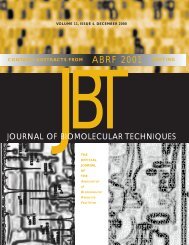Hydrology and water management in the humid tropics: proceedings ...
Hydrology and water management in the humid tropics: proceedings ...
Hydrology and water management in the humid tropics: proceedings ...
You also want an ePaper? Increase the reach of your titles
YUMPU automatically turns print PDFs into web optimized ePapers that Google loves.
esponse was an immediate <strong>and</strong> positive encouragement to UNESCO to develop <strong>the</strong><br />
concept fur<strong>the</strong>r. This was followed up by visitations of UNESCO personnel to <strong>the</strong><br />
Republic of Panama, <strong>in</strong> which <strong>the</strong> Republic confirmed that it <strong>in</strong>tended to support<br />
f<strong>in</strong>ancially <strong>and</strong> with physical facilities <strong>the</strong> site of <strong>the</strong> regional center. In June 1991 a<br />
formal letter of <strong>in</strong>tent was signed sett<strong>in</strong>g out <strong>the</strong> underst<strong>and</strong><strong>in</strong>g concern<strong>in</strong>g <strong>the</strong> center's<br />
establishment. UNESCO <strong>the</strong>n began deal<strong>in</strong>g directly with <strong>the</strong> Permanent Delegate to<br />
UNESCO of <strong>the</strong> Republic of Panama (The Honorable Arturo de la Guardia) <strong>in</strong><br />
development of <strong>the</strong> formal Agreement. In great part because of his dedicated<br />
assistance, <strong>in</strong> June 1992 representatives of <strong>the</strong> Government of Panama presented <strong>the</strong><br />
details of <strong>the</strong> proposed Center to <strong>the</strong> UNCED (United Nations Conference on<br />
Environmental Development) for <strong>the</strong> <strong>in</strong>formation <strong>and</strong> support of <strong>the</strong> delegates. In <strong>the</strong><br />
meantime, <strong>the</strong> process of selection among <strong>the</strong> c<strong>and</strong>idates for <strong>the</strong> position of Director<br />
began.<br />
On 13 November 1992 <strong>the</strong> Agreement between UNESCO <strong>and</strong> <strong>the</strong> Republic of<br />
Panama to establish CATHALAC (Centro del Agua del Trópico Húmedo para América<br />
Lat<strong>in</strong>a y El Caribe) was signed by <strong>the</strong> two entities. In January 1993 UNESCO assigned<br />
an Associate Expert (with <strong>the</strong> generous contribution of The Ne<strong>the</strong>rl<strong>and</strong>s) to Panama to<br />
assist <strong>in</strong> <strong>the</strong> prelim<strong>in</strong>ary organization of <strong>the</strong> Center. As a result of a change <strong>in</strong><br />
government <strong>in</strong> <strong>the</strong> Republic of Panama, <strong>the</strong>re was a brief period of <strong>in</strong>activity, dur<strong>in</strong>g<br />
which new pr<strong>in</strong>cipal directors of governmental agencies relative to CATHALAC were<br />
appo<strong>in</strong>ted. Dur<strong>in</strong>g this time, a contract was signed with <strong>the</strong> new CATHALAC Director,<br />
Sra. María Concepción Donoso. In October 1994 Ing. Rol<strong>and</strong>o Guillén, Director of<br />
Panama's Institute of Renewable Resources (INRENARE), was appo<strong>in</strong>ted by <strong>the</strong><br />
government to be <strong>the</strong> first Chairman of <strong>the</strong> CATHALAC Board of Governors. It was<br />
evident that Panama <strong>in</strong>tended that CATHALAC was to be a success.<br />
In November 1994 <strong>the</strong> first session of <strong>the</strong> Board of Governors of CATHALAC<br />
was held <strong>in</strong> Panama. The task before <strong>the</strong> Board at this meet<strong>in</strong>g was to establish <strong>the</strong><br />
work<strong>in</strong>g rules for future sessions of <strong>the</strong> Board, <strong>in</strong>clud<strong>in</strong>g <strong>the</strong> proposed program of work<br />
for CATHALAC. The Board members were also taken to <strong>the</strong> new offices of CATHALAC,<br />
<strong>the</strong>y be<strong>in</strong>g located idyllically on <strong>the</strong> premises of <strong>the</strong> former Fort Amador, at <strong>the</strong> Pacific<br />
entrance to <strong>the</strong> Panama Canal. The build<strong>in</strong>g was half of a duplex (formerly US Army<br />
officer hous<strong>in</strong>g), <strong>and</strong> was located at <strong>the</strong> entrance of <strong>the</strong> causeway lead<strong>in</strong>g out to <strong>the</strong><br />
former "Fortified Isl<strong>and</strong>s" that guarded <strong>the</strong> entrance to <strong>the</strong> canal. The causeway is<br />
narrow at this po<strong>in</strong>t, <strong>and</strong> <strong>the</strong> view from <strong>the</strong> office on its front side was <strong>the</strong> canal<br />
entrance. The view from <strong>the</strong> back was that of Panama Bay <strong>and</strong> <strong>the</strong> city of Panama. The<br />
facilities were more than adequate for <strong>the</strong> bus<strong>in</strong>ess of CATHALAC at that time. The<br />
Board was also pleased to note that <strong>the</strong> Republic of Panama had expressed <strong>the</strong> <strong>in</strong>tention<br />
to cont<strong>in</strong>ue <strong>the</strong> f<strong>in</strong>ancial support to <strong>the</strong> Center.<br />
On 22 March 1995 a formal dedication of <strong>the</strong> CATHALAC headquarters <strong>and</strong> <strong>the</strong><br />
programme were held. As a show of <strong>the</strong> strong back<strong>in</strong>g of <strong>the</strong> Government of <strong>the</strong><br />
Republic of Panama, His Excellency Licenciado Felipe Alej<strong>and</strong>ro Virzi, Senior Vice-<br />
President of <strong>the</strong> Republic cut <strong>the</strong> ribbon.<br />
S<strong>in</strong>ce that time, CATHALAC, as it has grown <strong>in</strong> its activities, has shifted its<br />
office location twice: first to <strong>the</strong> former Albrook AFB, <strong>and</strong> now (most appropriately) to<br />
<strong>the</strong> newly established Ciudad del Saber (City of Knowledge) that was established by <strong>the</strong><br />
Republic of Panama as an educational, scientific <strong>and</strong> high technology site us<strong>in</strong>g <strong>the</strong><br />
facilities of <strong>the</strong> former Fort Clayton. Its physical facilities have now exp<strong>and</strong>ed greatly to<br />
match its <strong>in</strong>creased activities. The Republic of Panama has cont<strong>in</strong>ued to support<br />
CATHALAC f<strong>in</strong>ancially <strong>and</strong> politically.<br />
CATHALAC's primary objective is to serve as an adm<strong>in</strong>istrative focal po<strong>in</strong>t for<br />
scientific <strong>and</strong> technical activities <strong>in</strong> <strong>the</strong> <strong>humid</strong> tropic regions of Lat<strong>in</strong> America <strong>and</strong> <strong>the</strong><br />
iv















